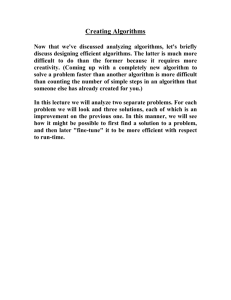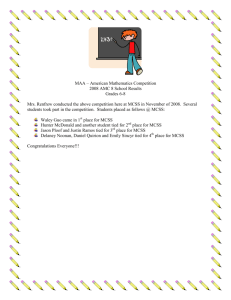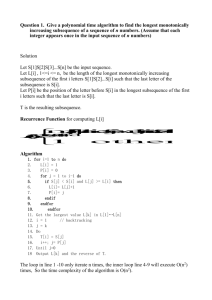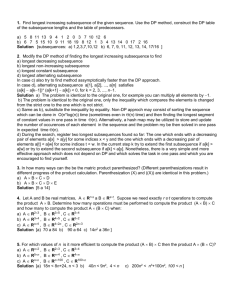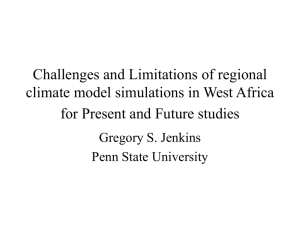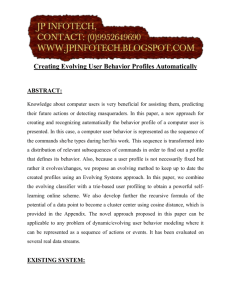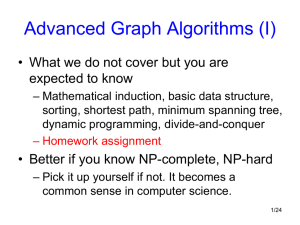Maximal Contiguous Subsequent Sum Problem
advertisement
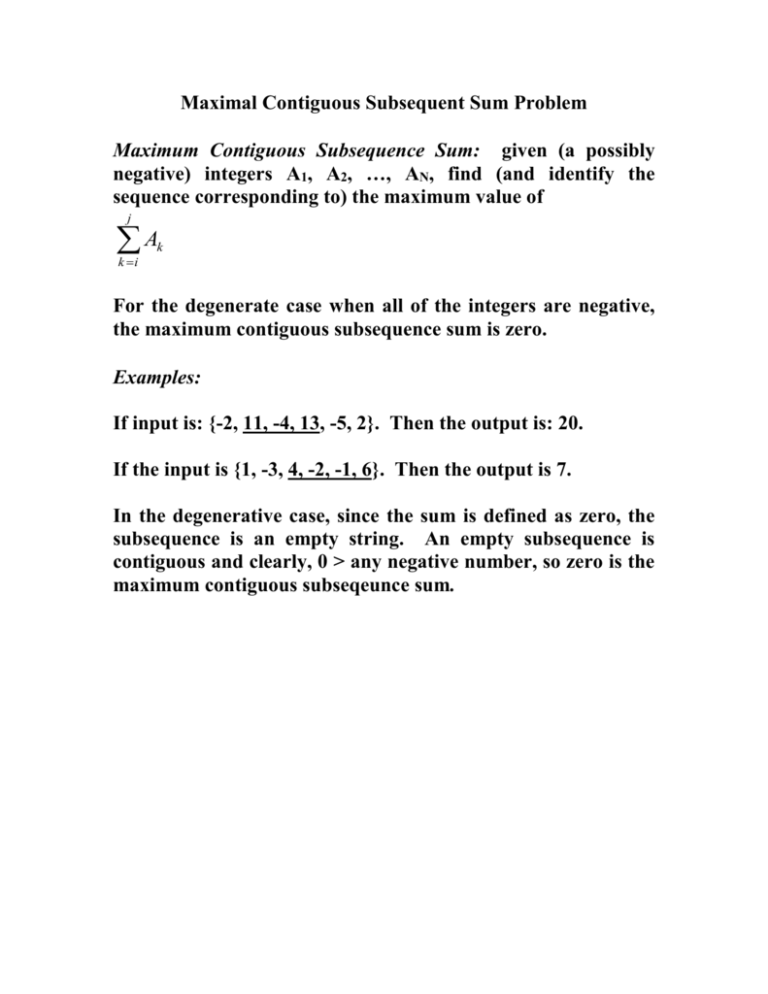
Maximal Contiguous Subsequent Sum Problem
Maximum Contiguous Subsequence Sum: given (a possibly
negative) integers A1, A2, …, AN, find (and identify the
sequence corresponding to) the maximum value of
j
A
k i
k
For the degenerate case when all of the integers are negative,
the maximum contiguous subsequence sum is zero.
Examples:
If input is: {-2, 11, -4, 13, -5, 2}. Then the output is: 20.
If the input is {1, -3, 4, -2, -1, 6}. Then the output is 7.
In the degenerative case, since the sum is defined as zero, the
subsequence is an empty string. An empty subsequence is
contiguous and clearly, 0 > any negative number, so zero is the
maximum contiguous subseqeunce sum.
The O(N3) Algorithm (brute force method)
public static int MCSS(int [] a) {
int max = 0, sum = 0, start = 0, end = 0;
// Cycle through all possible values of start and end indexes
// for the sum.
for (i = 0; i < a.length; i++) {
for (j = i; j < a.length; j++) {
sum = 0;
// Find sum A[i] to A[j].
for (k = i; k <= j; k++)
sum += a[k];
if (sum > max) {
max = sum;
start = i; // Although method doesn't return these
end = j; // they can be computed.
}
}
}
return max;
}
General Observation Analysis
Look at the three loops: the i loop executes SIZE (or N) times.
The j loop executes SIZE-1 (or N-1) times. The k loop executes
SIZE-1 times in the worst case (when i = 0). This gives a rough
estimate that the algorithm is O(N3).
Precise Analysis Using Big-Oh Notation
In all cases the number of times that, sum += a[k], is executed
is equal to the number of ordered triplets (i, j, k) where 1 i
k j N2 (since i runs over the whole index, j runs from i to
the end, and k runs from i to j). Therefore, since i, j, k, can
each only assume 1 of n values, we know that the number of
triplets must be less than n(n)(n) = N3 but i k j restricts this
even further. By combinatorics it can be proven that the
number of ordered triplets is n(n+1)(n+2)/6. Therefore, the
algorithm is O(N3).
A Simple Big-Oh Rule
A Big-Oh estimate of the running time is determined by multiplying the size
of all the nested loops together. BUT, THERE ARE EXCEPTIONS TO
THIS RULE!!!
The O(N2) Algorithm
Algorithm
public static int MCSS(int [] a) {
int max = 0, sum = 0, start = 0, end = 0;
// Cycle through all possible values of start and end indexes
// for the sum.
for (i = 0; i < a.length; i++) {
sum = 0;
for (j = i; j < a.length; j++) {
sum += a[j]; // No need to re-add all values.
if (sum > max) {
max = sum;
start = i; // Although method doesn't return these
end = j; // they can be computed.
}
}
}
return max;
}
Discussion of the technique and analysis
We would like to improve this algorithm to run in time better
than O(N3). To do this we need to remove a loop! The
question then becomes, “how do we remove one of the loops?”
In general, by looking for uncessary calculations, in this
specific case, uncessary calculations are performed in the
innerloop. The sum for the subsequence extending from i to j –
1 was just calculated – so calculating the sum of the sequence
from i to j shouldn’t take long because all that is required is
that you add one more term to the previous sum (i.e., add Aj ).
However, the cubic algorithm throws away all of this previous
information and must recompute the entire sequence!
Mathematically, we are utilizing the fact that:
j
A
k i
k
j 1
( Ak ) Aj
k i
The O(N) Algorithm (A linear algorithm)
Discussion of the technique and analysis
To further streamline this algorithm from a quadratic one to a
linear one will require the removal of yet another loop.
Getting rid of another loop will not be as simple as was the first
loop removal. The problem with the quadratic algorithm is
that it is still an exhaustive search, we’ve simply reduced the
cost of computing the last subsequence down to a constant
time (O(1)) compared with the linear time (O(N)) for this
calculation in the cubic algorithm. The only way to obtain a
subquadratic bound for this algorithm is to narrow the search
space by eliminating from consideration a large number of
subsequences that cannot possibly affect the maximum value.
How to eliminate subsequences from consideration
i
j j+1
A
<0
B
q
Sj+1, q
C < Sj+1, q
If A < 0 then C < B
j
If
A
k i
k
0 , and if q > j, then Ai…Aq is not the MCSS!
Basically if you take the sum from Ai to Aq and get rid of the
first terms from Ai to Aj your sum increases!!! Thus, in this
situation the sum from Aj+1 to Aq must be greater than the sum
from Ai to Aq. So, no subsequence that starts from index i and
ends after index j has to be considered.
So – if we test for sum < 0 and it is – then we can break out of
the inner loop. However, this is not sufficient for reducing the
running time below quadratic!
Now, using the fact above and one more observation, we can
create a O(n) algorithm to solve the problem.
i 1
i
A , A
If we start computing sums
k i
j
the first value j such that
A
k i
k
k
k i
k
, etc. until we find
0 , then immediately we
know that either
1) The MCSS is contained entirely in between Ai to Aj-1 OR
2) The MCSS starts before Ai or after Aj.
From this, we can also deduce that unless there exists a
subsequence that starts at the beginning that is negative, the
MCSS MUST start at the beginning. If it does not start at the
beginning, then it MUST start after the point at which the sum
from the beginning to a certain point is negative.
So, using this how can we come up with an algorithm?
1) We can compute intermediate sums starting at i=0.
2) When a new value is added, adjust the MCSS accordingly.
3) If the running sum ever drops below 0, we KNOW that if
there is a new MCSS than what has already been calculated, it
will start AFTER index j, where j is the first time the sum
dropped below zero.
4) So now, just start the new running sum from j+1.
Algorithm
public static int MCSS(int [] a) {
int max = 0, sum = 0, start = 0, end = 0, i=0;
// Cycle through all possible end indexes.
for (j = 0; j < a.length; j++) {
sum += a[j]; // No need to re-add all values.
if (sum > max) {
max = sum;
start = i; // Although method doesn't return these
end = j; // they can be computed.
}
else if (sum < 0) {
i = j+1; // Only possible MCSSs start with an index >j.
sum = 0; // Reset running sum.
}
}
return max;
}
Discussion of running time analysis
The j loop runs N times and the body of the loop contains only
constant time operations, therefore the algorithm is O(N).
MCSS Linear Algorithm Clarification
Whenever a subsequence is encountered which has a negative
sum – the next subsequence to examine can begin after the end
of the subsequence which produced the negative sum. In other
words, there is no starting point in that subsequence which will
generate a positive sum and thus, they can all be ignored.
To illustrate this, consider the example with the values
5, 7, -3, 1, -11, 8, 12
You'll notice that the sums
5,
5+7,
5+7+(-3) and
5+7+(-3)+1
are positive, but
5+7+(-3)+1+(-11) is negative.
It must be the case that all subsequences that start with a value
in between the 5 and -11 and end with the -11 have a negative
sum. Consider the following sums:
7+(-3)+1+(-11)
(-3)+1+(-11)
1+(-11)
(-11)
Notice that if any of these were positive, then the subsequence
starting at 5 and ending at -11 would have to be also. (Because
all we have done is stripped the initial positive subsequence
starting at 5 in the subsequences above.) Since ALL of these
are negative, it follows that NOW MCSS could start at any
value in between 5 and -11 that has not been computed.
Thus, it is perfectly fine, at this stage, to only consider
sequences starting at 8 to compare to the previous maximum
sequence of 5, 7, -3, and 1.
